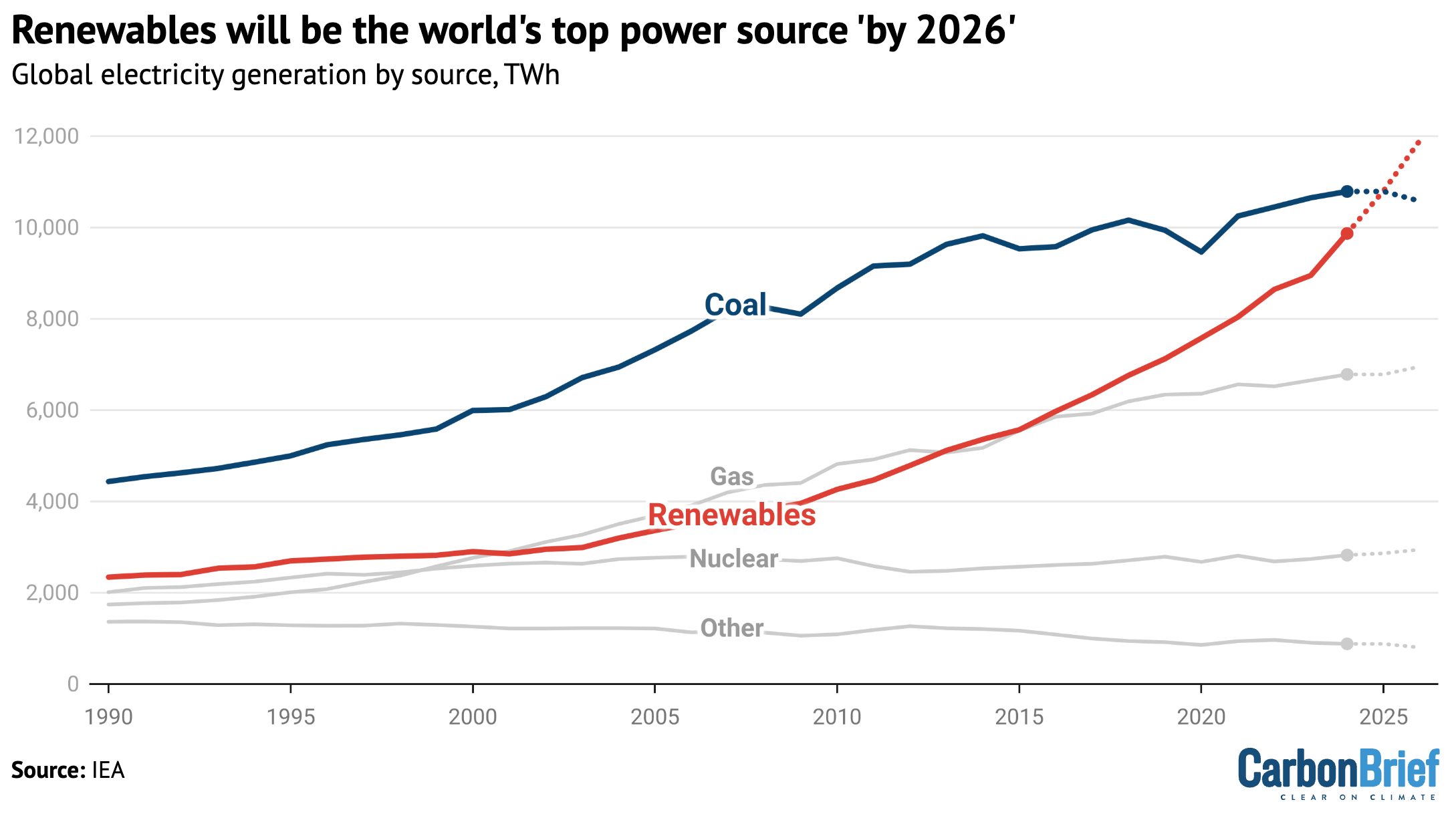Renewable energy will overtake coal to become the world’s top source of electricity “by 2026 at the latest”
from Bob Burton CoalWire Published by Global Energy Monitor
IEA forecasts coal demand to plateau in 2025 and 2026: The International Energy Agency (IEA) estimates that the rapid growth in wind and solar capacity is likely to drive renewable generation to exceed coal power “by 2026 at the latest”. The agency’s Electricity Mid-Year Update 2025 estimates that favourable wind and rainfall conditions could result in renewables exceeding coal generation this year. The IEA forecasts that wind and solar will account for about 90 per cent of the increase in global electricity demand to 2026, with renewables likely to reach 36 per cent of global power generation compared to coal power’s share of 32 per cent. The IEA’s Coal Mid-Year Update estimates a marginal increase in global coal demand in 2025 to 1180 million tonnes, primarily due to import demand from Asia, with Chinese imports increasing by 14 per cent in 2024 to a record 548 million tonnes. The agency suggests a decline in coal consumption in 2025 of one per cent in China, a two per cent fall in Europe and a seven per cent increase in the US. The IEA estimates a decline in the coal export trade in both 2025 and 2026, with the most significant downturns in Indonesia and Russia. (Carbon Brief, International Energy Agency, International Energy Agency [Pdf])
Abstract
Coal’s role in the global energy system today remains significant. Over the past decade, the world’s demand for coal has stayed relatively stable, apart from a temporary drop during the Covid-19 pandemic and the rapid rebound that followed. Today, global coal consumption, power generation, production and trade are all at record levels. In many countries, coal continues to be the leading source of electricity generation, helping to meet growing energy needs. These trends carry major implications for energy security, affordability and sustainability, especially as coal remains the single largest contributor to energy-related carbon dioxide emissions. While the large majority of the world’s coal use is concentrated in Asia, particularly China, consumption in Europe and North America remains considerable. Coal’s influence therefore remains global in both energy and climate discussions.
The International Energy Agency’s 2025 Coal Mid-Year Update reviews the latest trends in coal demand, production, trade and prices. It includes preliminary data for the first half of 2025 and provides updated forecasts for 2025 and 2026, grounded in recent market developments and economic conditions.
Renewable energy will overtake coal to become the world’s top source of electricity “by 2026 at the latest”, according to new forecasts from the International Energy Agency (IEA).
The rise of renewables is being driven by extremely rapid growth in wind and solar output, which topped 4,000 terawatt hours (TWh) in 2024 and will pass 6,000TWh by 2026.
Wind and solar are increasingly under attack from populist politicians on the right, such as US president Donald Trump and Reform in the UK.
Nevertheless, they will together meet more than 90% of the increase in global electricity demand out to 2026, the IEA says, while modest growth for hydro power will add to renewables’ rise.
With nuclear and gas also reaching record highs by 2026, coal-fired generation is set to decline – driven by falls in China and the EU – meaning that power-sector emissions will decline, too.
The chart below illustrates these profound shifts in the global electricity mix – in particular, the meteoric rise of renewables, driven by wind and solar.

The IEA says that renewables could overtake coal as early as this year, depending on weather-related impacts on the output of wind and hydro capacity.
It adds that the switch will happen by 2026 “at the latest”, when renewables are expected to make up 36% of global power supplies, against just 32% from coal – the fuel’s lowest share in a century.
The share of global electricity generation coming from wind and solar combined will rise from 1% in 2005 and 4% in 2015 to 15% in 2024, 17% in 2025 and nearly 20% in 2026.
The global reduction in coal-fired electricity generation will result from declines in China and the EU, which will only be partially offset by increases in the US, India and other Asian nations.
The IEA attributes the coming decline of coal to “continued renewables growth and higher coal-to-gas switching in multiple regions”. It says gas power will rise by 1.3% this year and next.
For nuclear, the IEA says that the new record output will result from plant restarts in Japan, “robust” output in France and the US, as well as new reactors in China, India and South Korea.
The shift to wind and solar is happening despite global electricity demand being forecast to grow much faster over the next two years – at 3.3% and 3.7%, respectively – than the 2.6% average for 2015-2023.
The IEA says new demand is coming from industry, domestic appliances, growing use of air conditioning, ongoing electrification of heat and transport, as well as the expansion of data centres.
